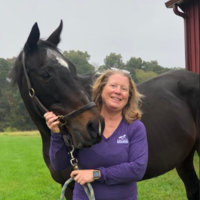
The Most Popular Horse Breeds Of 2019
Equestrian Advice & Guides General Equestrian
Build your business profile for FREE and expose your services to thousands of potential clients!
Create my profile now!
Cutting hay brings about changes that engender new ones, and bountiful opportunities in addition to the anticipated harvest. First and second cuttings yield hay for horses and other animals, or, in our area, a fertile source of growth for the mushroom industry outside Philadelphia. Organic or not, growing hay establishes a natural cycle of growth.
For my horse and me, cutting time gives us more room to ride and play in the fields, weaving in and out of the rows, ever careful not to disturb them. Forward, backward, sideways in a controlled dance that protects the hay ready to be baled. Our horizons have widened as more fields are now accessible to us. Yippee!
Our entire view changes completely. We can now see things we had not seen for months such as the old farmhouse next door and barns in the distance. Colors change rapidly from the tawny mix of green and gold to a rich mustardy brown earth tone, soon to become verdant with new growth.
Perhaps the most joyful inhabitants of this land are the predators who profit from the disturbance to small birds, rodents, and insects that had been taking cover in the tall grasses. Hawks of all sizes, the smaller Sharpshins and Coopers and the larger goshawks just beginning to arrive for fall, fly with agility and purpose across an exposed landscape to prey on voles, mice, and so many more tasty treats. In the nocturnal hours, one can hear the eerie cry of the screech owls, a threat to the tiny creatures below them as they watch from high overstory and plunge with speed and alacrity to the fields below.
Throughout the day, birds forage for seeds, shoots, insects, and worms. One day last week, the intelligent, crafty crows tipped me off on my way to the barn, and for that, I am humbly grateful. Not far away, I passed them, unconcerned by my presence. But with a sudden surge of terror and urgency, they leapt into the air and took flight, wings beating powerfully in a serious effort to flee. I froze, knowing that something exciting was coming, as only a large predator could scare a brassy crow. Eyes to the sky, seconds later, the greatest predator of them all, the bald eagle, flew above me, not that high above the ground or me. The majestic bird flew intentionally across the fields to a destination farther away, perhaps the river. In just a few seconds, so much had happened. There was no time to grab my phone for a photo, and my binoculars were back in the house, so I stood there in awe and wonder, watching the formidable hunter cross my path. I might have missed that opportunity had it not been for the warning from the dark birds.
Now, the fields are clear, already cut and baled for the next cutting. The large bales are on their way to the mushroom farmers who, in turn, will begin their process again. Fall migration has begun, and more hawks will arrive, harbingers of cooler temperatures and the end of the hay season in the Northeast. My horse and I will keep riding around the same fields until the next crop grows high, and we will keep our eyes open for all the bounty that nature has to offer, and most importantly, do our very best to preserve the land and serve the wildlife around us.

